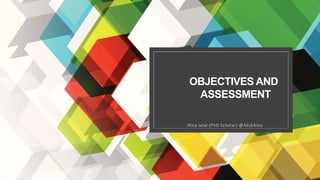
Objectives and assessment
- 1. OBJECTIVES AND ASSESSMENT Hina Jalal (PhD Scholar) @AksEAina
- 2. Objectives are the desired outcomes of an effort. Guided by these specific objectives instructional activities are designed and subsequently assessment is carried out through different methods. The objective are key components for developing a test and guiding principles for assessment. Bloom’s taxonomy provides a useful way of describing the complexity of an objective by classifying into one of the hierarchical categories from simplest to complex. Therefore, the process of developing a test should begin with the identification of content domain at first stage and development of table of specification at second stage. A learning objective refers to the statement of what students will obtain through instruction of certain content. In other words ‘an objective is a description of a performance you want learners to be able to exhibit before you consider them competent. An objective describes an intended result of instruction, rather than he process of instruction itself.’ (Mager, p. 5) Learning Objectives
- 3. Purpose of Educational Aims, Goals and Objectives Provide direction for the instructional process (by clarifying the intended leanring outcomes) COnvey instructional intent to others (students, parents, academia, and society) Provide a basis for assessing students learning (by describing the perfromance to obe measured) Figure 1 Courtesy by Robert Linn (2008)
- 4. Difference between learning objectives and learning outcomes Learning objectives refer to teachers’ intentions for learners, such as what students will be taught during the course or program. It is important to note that learning objectives reflect what teachers do. Learning outcomes are statements of what a student will be able to do or demonstrate at the completion of a certain sequence of learning (course, program). Learning outcomes are mainly concerned with the achievements of the learner and less with the intentions of the teacher. Learning outcomes inform students of what is expected of them in terms of performance, to achieve desired grades and credits.
- 5. Purposes of test Monitoring Student Progress Diagnosing Learning Problems Assigning Grades Classification and Selection of Students Evaluating Instruction
- 6. Characteristics/ Attributes of the Objectives Behaviour - Firstly, an objective must explain the competency to be learned, the intended change in the behaviour of the learners. Criterion - Secondly, an objective must clarify the intended degree of In other words objective should not only indicate the change in the behaviour of the students but also the level or degree of that change as well. Conditions - Thirdly, an objective should describe the conditions under which the learning will occur.
- 7. Taxonomy of Educational Objectives Taxonomies help us answer some key questions on learning, teaching and curriculum structure: ‘What do we want students to learn?’, ‘Why do we want them to learn that?’ and ‘How can we know that they learn that?’. Learning taxonomies are the source of learning outcomes and facilitate the shift from a teacher-centered approach to a more student-centered approach, focused on learning. The meaning of the term taxonomy originates from the Greek ‘taxis’ (‘arrangement’) and ‘nomia’ (‘distribution’). In their current understanding, taxonomies represent ‘distribution by categories’ or, simply said, ‘classifications’. Learning taxonomies are a classification able to organize the knowledge, skills, values, or behaviors that teachers aim to teach. Learning taxonomies are used to organize different stages of learning development, providing a practical framework for selecting the appropriateness of specific learning outcomes for courses at different levels of complexity. In education, the most well-known taxonomy is that developed by Bloom in the 1950s.
- 8. Bloom's taxonomy The committee identified three domains of educational activities or learning (Bloom, et al. 1956): 1. Cognitive: mental skills (knowledge) 2. Affective: growth in feelings or emotional areas (attitude or self) 3. Psychomotor: manual or physical skills (skills)
- 10. Effective Domain The affective domain is one of three domains in Bloom's Taxonomy, with the other two being the cognitive and psychomotor presented by Krathwohl, Bloom, and Masia in 1973. Skills in the affective domain describe the way people react emotionally and their ability to feel other living things' pain or joy. Affective objectives typically target the awareness and growth in attitudes, emotion, and feelings. There are five levels in the affective domain moving through the lowest-order processes to the highest.
- 12. SOLO Taxonomy SOLO taxonomy was developed by Biggs and Collis (1982) Stands for Structure of Observed Learning Outcomes
- 13. PRINCIPLES FOR TEST CONTENT 1) Purpose of the test (diagnostic test, classification, placement, or job employment) 2) Representative sample of the knowledge, behaviour, or skill domain being measured. 3) Relevancy of the topic with the content of the subject 4) Language of the content should be according to the age and grade level of the students. 5) Developing table of specification.
- 14. Table of Specification A sample of pupil performance is more likely to be representative if a set of specifications is used in planning the test. Test specifications define and limit the achievement domain to be measured and describe the sample of test items to be prepared. One form of specifications is a two-way chart, called a table of specification. Table of specification involves: (i) Obtaining the list of instructional objectives (ii) Outlining the course content, (ii) Prepare the two-way chart that relates the type instructional objectives to course content.
